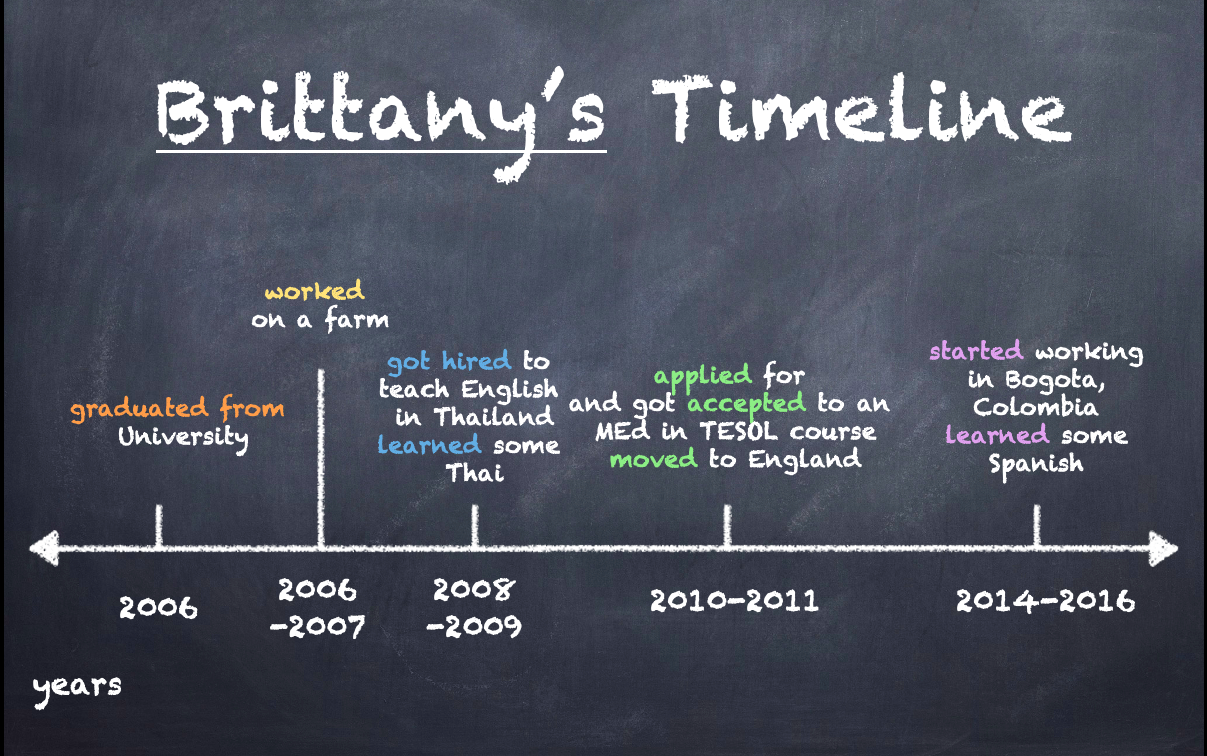4.4: - Ed Endings
- Page ID
- 63744
Final -Ed Sound
Rules to Remember
We pronounce the final -ed in three ways. Listen to the words from the Ted Talk "Do schools kill creativity?" Do you hear a /d/, /t/, or /əd/? Rules to Remember - ed endings.m4a
Circle the sound you hear:
- needed, started, graduated /d/ /t/ /əd/
- talked, watched, helped /d/ /t/ /əd/
- explained, bothered, turned /d/ /t/ /əd
- If the word ends in /t/ or /d/ (need, start), add the syllable /əd/ or /ɪd/.
- If the word ends in an unvoiced sound (talk, watch), add a /t/ sound.
- If the word ends in a voiced sound (bother, explain), add a /d/ sound.
Review: Voiced and Unvoiced
If you’re not sure which word endings are voiced or unvoiced, put your hand on your throat.
- You will feel a vibration on your throat and your hand if words end in voiced consonants.
- You will NOT feel a vibration on your throat and your hand if words end in unvoiced consonants.
Examples: -Ed Endings
| Types of -Ed Endings | Examples |
|---|---|
|
Use /t/ after unvoiced final sounds /f/, /k/, /p/,/s/, /ʧ/(ch), /ʃ/(sh), /θ/(th) |
Words that end with a /t/ sound:
|
|
Use /d/ after voiced final sounds /b/, /g/, /ʤ/(j), /l/, /m/, /n/, /ŋ/, /r/, /ð/(th), /v/, /z/, + vowels |
Words that end with a /d/ sound:
|
|
Use /əd/ or /ɪd/ after final /d/ and /t/ . Remember that /əd/ adds an extra syllable |
Words that end with an /əd/ sound:
|
Practice -Ed Endings
Listen and repeat the words in the table. Practice -Ed endings.m4a
|
/t/ |
/d/ |
/əd/ or /ɪd/ |
|---|---|---|
_____________________ _____________________ _____________________ _____________________ _____________________ _____________________ _____________________ _____________________ |
_____________________ _____________________ _____________________ _____________________ _____________________ _____________________ _____________________ _____________________ |
_____________________ _____________________ _____________________ _____________________ _____________________ _____________________ _____________________ |
Change the following words to past tense (add ed), and then add them to the table in the correct column above.
dance invent cook vaccum marry wash
join create live belong end
Watch the Video
Elemental English: -Ed Endings
Video Questions 1
Choose the correct answer.
- What is the final sound you hear when you say walked?
- /d/
- /t/
- /əd/ or /ɪd/
- What is the final sound you hear when you say smelled?
- /d/
- /t/
- /əd/ or /ɪd/
- What is the final sound you hear when you say visited?
- /d/
- /t/
- /əd/ or /ɪd/
- When a sound is voiced (like /v/, / g/, / p/, or /d/) you . .
- don't feel a vibration in your throat
- feel a vibration in your throat
- When a sound is unvoiced (like /f/, /k/, /b/, or /t/) you . . .
- don't feel a vibration in your throat
- feel a vibration in your throat
- ”Unvoiced" and "voiceless" mean the same thing.
- true
- false
- Is the final sound in the word "vow" voiced or unvoiced?
- unvoiced
- voiced
- Is the final sound in the word "fake" voiced or unvoiced?
- unvoiced
- voiced
- Is the final sound in the word "tape" voiced or unvoiced?
- unvoiced
- voiced
- Is the final sound in the word "gaze" voiced or unvoiced?
- unvoiced
- voiced
Video Questions 2
Choose the correct "ed" ending sound for each word.
- vowed
- /d/
- /t/
- /əd/ or /ɪd/
- faked
- /d/
- /t/
- /əd/ or /ɪd/
- gazed
- /d/
- /t/
- /əd/ or /ɪd/
- taped
- /d/
- /t/
- /əd/ or /ɪd/
- decided
- /d/
- /t/
- /əd/ or /ɪd/
- waited
- /d/
- /t/
- /əd/ or /ɪd/
Linking: -Ed Endings
Rules to Remember
- When the word after -ed begins with a vowel, the past tense ending is clear.
- Example: I lived in Thailand. (sounds like live-din)
- When the word after -ed begins with /d/ or /t/, the past tense ending is difficult to hear.
- Example: Tommy looked tired. (sounds like (look-tired)


Listening Practice: Linking -Ed Endings
- Listen. Circle the sentence you hear.
- Share your answers with a partner. Which sentences were most difficult to hear?
- Listen to your teacher read both sentences in each question. Repeat and listen to the differences in each sentence.
- In pairs, partner A read either a or b. Partner B, guess which sentence your partner read. When you're finished, change roles.
| Number | Sentence |
|---|---|
| 1 |
a. We always bother other students. b. We always bothered other students. |
| 2 |
a. I talk to the doctor every day. b. I talked to the doctor every day. |
| 3 |
a. You turned in your homework. b. You turn in your homework. |
| 4 |
a. They started to dance. b. They start to dance. |
| 5 |
a. I study every night. b. I studied every night. |
| 6 |
a. You work too much. b. You worked too much. |
| 7 |
a. I need to speak with him. b. I needed to speak with him. |
| 8 |
a. The doctor turned on the radio. b. The doctor turns on the radio. |
| 9 |
a. You look tired. b. You looked tired. |
| 10 |
a. I live in Thailand. b. I lived in Thailand. |
Recording: Linking -ed Endings to Vowels and Consonants
Read each of the sentences. Focus on linking the -ed ending to the following word.
- Gillian’s mother talked to the doctor.
- She explained that Gillian was having problems in school.
- Gillian bothered other students.
- She turned in her homework late.
- The doctor turned on the radio.
- She started to dance.
Talk about a Timeline
Brittany's Timeline
- Look at Brittany’s timeline and listen to her talk about important events in her life.
- Use Brittany’s timeline. Practice telling your partner about her life. Use the correct -ed endings.
Example: She graduated form university in 2006. Then she worked on a farm from 2006 to 2007. . . .

Caption: Above is an image of a timeline that describes important events in Brittany's life. The following information is included:
| Important Events | graduated from university | worked on a farm | got hired to teach English in Thailand and learned some Thai | applied for and got accepted to an MEd in TESOL course and moved to England | started working in Bogota, Colombia and learned some Spanish |
|---|---|---|---|---|---|
| Year | 2006 | 2006-2007 | 2008-2009 | 2010-2011 | 2014-2016 |
Your Timeline
- Draw your own timeline like the ones above.
- Make a video of yourself describing the timeline of important events in your life. Then post your video in your class's online forum.
- Watch your classmate's videos. Write a comment or questions to at least 2 classmates.
Listening Practice
Listen to a summary of the story Sir Ken Robinson told about Gillian. Complete the story with the missing words. Summary of Gillian Lynne Story.m4a
Recording: -Ed Endings
____/ 24 points
- Read the summary of Sir Ken Robinson’s story about Gillian Lynne. Decide if each “ed” ending should be pronounced as a /t/, /d/, or /əd/.
- Practice reading the story out loud with a partner.
- When you’re ready. Record yourself reading the story and submit your video. You will receive one point for each -ed ending that you pronounce correctly and one point for each -ed ending that is correctly linked tot he following word.
Summary
Gillian had a lot of problems in school. She couldn’t concentrate or sit still, so the school thought Gillian had a learning disorder.
Her mother took Gillian to see a special doctor. Gillian’s mother talked to the doctor for 20 minutes. She explained that Gillian bothered other students and she turned in her homework late. Then the doctor told Gillian he needed to speak to her mother privately, and the doctor and Gillian’s mother went outside.
Before he left the room, the doctor turned on the radio. After they left the room, the doctor and Gillian’s mom watched Gillian. Gillian immediately started to dance. The doctor told Gillian’s mom: “Gillian isn’t sick. She’s a dancer. Take her to dance school.”
After that, Gillian went to a dance school and it was wonderful. There were many children at the school just like Gillian. They all needed to move in order to think. They did many kinds of dance including tap, jazz, and ballet. Gillian became a very successful dancer. She graduated from the Royal Ballet School, and founded the Gillian Lynne Dance Company. She helped create some very successful musical theater productions and she became very wealthy.


